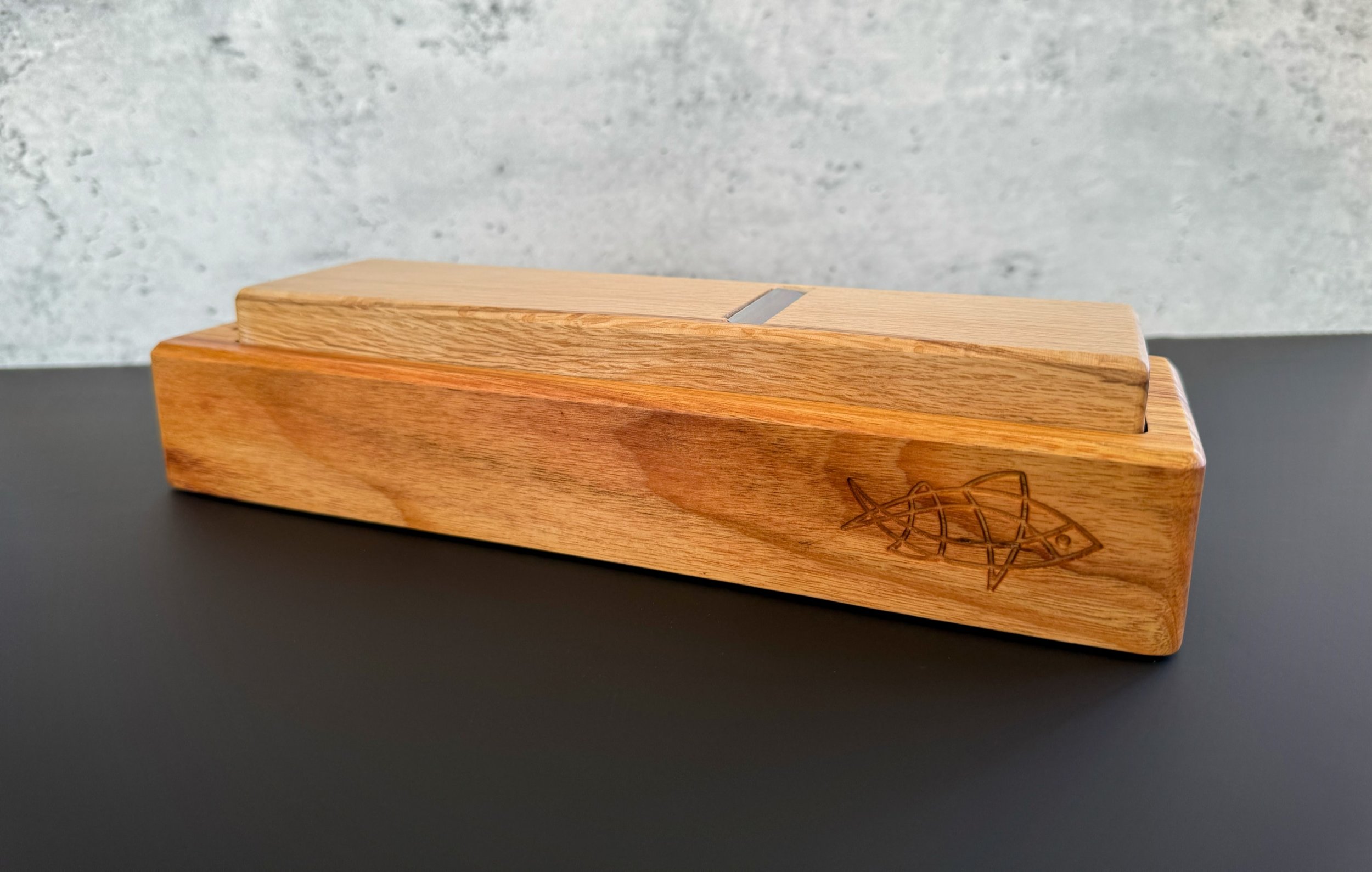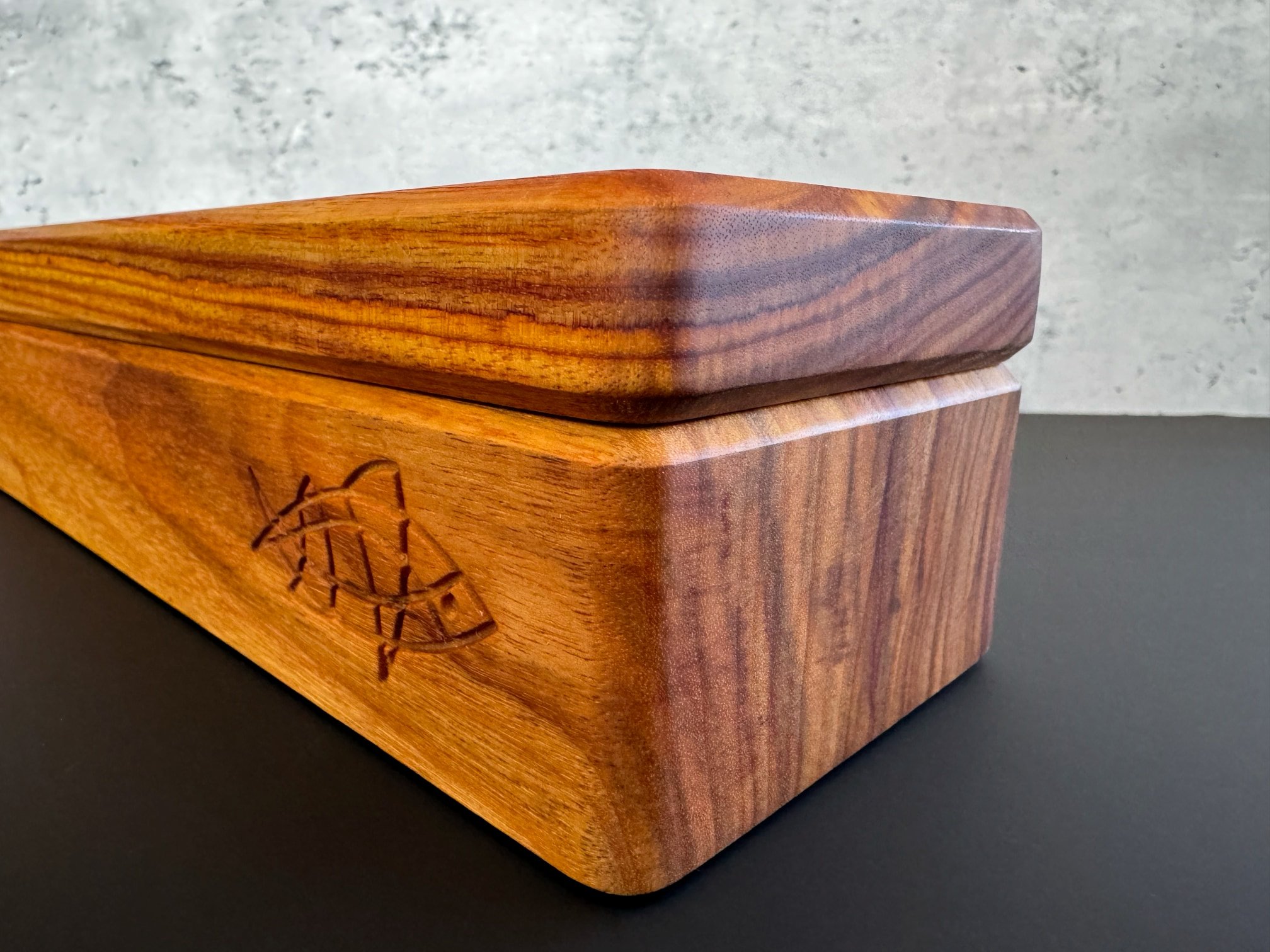KATSUOBUSHI KEZURIKI (Traditional Dried Bonito Shaver)
A katsuobushi kezuriki (鰹節削り器; かつおぶしけずりき) is a traditional Japanese kitchen utensil, similar to a wood plane or mandoline. It is used to shave katsuobushi, dried blocks of skipjack tuna (katsuo). The technique used to prepare the cooking ingredient is pulling and pushing a block of katsuobushi across the blade in the device in a back-and-forth movement. The resulting shavings are captured in a wooden drawer at the bottom of the utensil.
The shavings are a staple of Japanese cuisine. Larger, thicker shavings, called kezurikatsuo (削り鰹; けずりかつお), are boiled with kombu to make dashi. Smaller, thinner shavings, called hanakatsuo (花鰹; はなかつお), are used as a flavoring and as a topping for many Japanese dishes, such as okonomiyaki. Today, many Japanese households no longer use the katsuobushi kezuriki, opting instead to buy packages of already-shaved hanakatsuo or kezurikikatsuo at supermarkets.
MAKING KATSUOBUSHI
skipjack tuna (Katsuwonus pelamis)
The catch of skipjack tuna will pass through steps of cutting, basket placement, stewing, boiling, deboning, and smoking and drying to produce a completed block called an arabushi. The arabushi then has its rough surface shaved down before having mold applied and dried in the sun repeatedly. The completed product is then called a karebushi.
1. Cutting
Head & entrails removed, blood drained. Fish is then sliced in three: the back loin, belly loin, and backbone section.
2. Basket
Cuts are arranged in baskets, will determine the shape of the katsuobushi.
3. Stewing
Cuts are stewed for 1-2 hours, then cooled to toughen up the meat.
4. Smoking and Drying
Cuts are smoked with oak firewood. Smoking draws out moisture and prevents bacteria from occurring.
5. Finished Arabushi
Cuts are smoked and then cooled repeatedly over a period of 2-3 weeks. The process from catch to finished arabushi takes about one month.
6. Shaving
The surfaces of the arabushi are shaved and prepared for coating with mold.
7. Mold Coating and Drying
The arabushi is fermented with high quality mold. Repeatedly coating with mold and drying will increase its umami, aroma and preserves it for longer.
8. Finished Karebushi
After two passes or more of mold coating, the arabushi now qualifies as karebushi. The process from catch to finished karebushi takes 2-3 months.
* when the arabushi is put through at least three or four passes of mold coating, the katsuobushi is called honkarebushi, said to be the highest grade of katsuobushi.
With the perfect union of the belly (mebushi, or "female cut") and back loin cuts (obushi, or "male cut"), katsuobushi is meant to symbolize a happy couple.
Bonito and Saxifrage, c. 1832-1833 | Utagawa Hiroshige
CANARYWOOD KEZURIKI
KATSUOBUSHI KEZURIKI PROTOTYPING
Awase dashi (合わせだし) | Yield – 800ml
This is the most common of all Japanese stocks. It can be used in soups, stews, hotpots and rice dishes.
Ingredients
10g kombu (about 4x4 inches)
10g freshly shaved katsuobushi (or 1 cup packed)
1l water (or about 4 cups)
Method
Add water to a pan and soak the Kombu for thirty minutes to an hour.
Heat the pan just until small bubbles start to form on the bottom of the pan.
Take off the heat and remove the kombu, then add katsuobushi, and leave to infuse for one or two minutes.
Strain the dashi through a fine-mesh sieve. Do not squeeze the cloth to extract more dashi. This squeezes out impurities, such as protein, from the flakes.
Keep it in the refrigerator for 3–5 days or in the freezer for 2 weeks.














